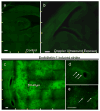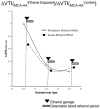Ethanol exposure during pregnancy persistently attenuates cranially directed blood flow in the developing fetus: evidence from ultrasound imaging in a murine second trimester equivalent model
- PMID: 22141380
- PMCID: PMC3297711
- DOI: 10.1111/j.1530-0277.2011.01676.x
Ethanol exposure during pregnancy persistently attenuates cranially directed blood flow in the developing fetus: evidence from ultrasound imaging in a murine second trimester equivalent model
Abstract
Background: Ethanol (EtOH) consumption during pregnancy can lead to fetal growth retardation, mental retardation, and neurodevelopmental delay. The fetal brain initiates neurogenesis and vasculogenesis during the second trimester, and depends on maternal-fetal circulation for nutrition and growth signals. We used high-resolution in vivo ultrasound imaging to test the hypothesis that EtOH interferes with fetal brain-directed blood flow during this critical developmental period.
Methods: Pregnant mice were lightly anesthetized on gestational day 12 with an isoflurane/oxygen mixture. We assessed the effect of single and repeated binge-like maternal EtOH exposures at 3 g/kg, administered by intragastric gavage or intraperitoneal injection, on maternal circulation and fetal umbilical, aortic, internal carotid, and middle cerebral arterial circulation.
Results: Binge maternal EtOH exposure, regardless of exposure route, significantly reduced fetal arterial blood acceleration and velocity time integral (VTI), from umbilical to cerebral arteries, without a change in fetal heart rate and resistivity indices. Importantly a single maternal binge EtOH exposure induced persistent suppression of fetal arterial VTI for at least 24 hours. Repeated binge episodes resulted in a continuing and persistent suppression of fetal VTI. Qualitative assessments showed that maternal EtOH exposure induced oscillatory, nondirectional blood flow in fetal cerebral arteries. Maternal cardiac and other physiological parameters remained unaltered.
Conclusions: These data show that binge-type maternal EtOH exposure results in rapid and persistent loss of blood flow from the umbilical artery to the fetal brain, potentially compromising nutrition and the maternal/fetal endocrine environment during a critical period for neuron formation and angiogenesis in the maturing brain.
Copyright © 2011 by the Research Society on Alcoholism.
Figures











Similar articles
-
Maternal alcohol exposure during mid-pregnancy dilates fetal cerebral arteries via endocannabinoid receptors.Alcohol. 2017 Jun;61:51-61. doi: 10.1016/j.alcohol.2017.01.014. Epub 2017 May 18. Alcohol. 2017. PMID: 28554529 Free PMC article.
-
Maternal alcohol consumption producing fetal alcohol spectrum disorders (FASD): quantity, frequency, and timing of drinking.Drug Alcohol Depend. 2013 Dec 1;133(2):502-12. doi: 10.1016/j.drugalcdep.2013.07.013. Epub 2013 Aug 8. Drug Alcohol Depend. 2013. PMID: 23932841 Free PMC article.
-
Fetal Alcohol Exposure Alters Blood Flow and Neurological Responses to Transient Cerebral Ischemia in Adult Mice.Alcohol Clin Exp Res. 2017 Jan;41(1):117-127. doi: 10.1111/acer.13277. Epub 2016 Dec 17. Alcohol Clin Exp Res. 2017. PMID: 27987329 Free PMC article.
-
Fetal Cerebral Circulation as Target of Maternal Alcohol Consumption.Alcohol Clin Exp Res. 2018 Jun;42(6):1006-1018. doi: 10.1111/acer.13755. Epub 2018 May 9. Alcohol Clin Exp Res. 2018. PMID: 29672868 Free PMC article. Review.
-
Vascular effects of maternal alcohol consumption.Am J Physiol Heart Circ Physiol. 2012 Aug 15;303(4):H414-21. doi: 10.1152/ajpheart.00127.2012. Epub 2012 Jun 22. Am J Physiol Heart Circ Physiol. 2012. PMID: 22730388 Free PMC article. Review.
Cited by
-
Autophagy is involved in ethanol-induced cardia bifida during chick cardiogenesis.Cell Cycle. 2015;14(20):3306-17. doi: 10.1080/15384101.2015.1087621. Cell Cycle. 2015. PMID: 26317250 Free PMC article.
-
Neurotrophins in the Brain: Interaction With Alcohol Exposure During Development.Vitam Horm. 2017;104:197-242. doi: 10.1016/bs.vh.2016.10.008. Epub 2016 Nov 29. Vitam Horm. 2017. PMID: 28215296 Free PMC article. Review.
-
Sex-specific alterations in cognitive control following moderate prenatal alcohol exposure and transient systemic hypoxia ischemia in the rat.Alcohol Clin Exp Res (Hoboken). 2024 Apr;48(4):640-652. doi: 10.1111/acer.15276. Epub 2024 Feb 1. Alcohol Clin Exp Res (Hoboken). 2024. PMID: 38302722 Free PMC article.
-
The Impact of Prenatal Alcohol Exposure on Longitudinal Growth, Nutritional Status, and Insulin-Like Growth Factor 1 in Early Childhood in Leyte, the Philippines.J Pediatr. 2024 Jun;269:113977. doi: 10.1016/j.jpeds.2024.113977. Epub 2024 Feb 23. J Pediatr. 2024. PMID: 38401788 Free PMC article.
-
CD24 expression identifies teratogen-sensitive fetal neural stem cell subpopulations: evidence from developmental ethanol exposure and orthotopic cell transfer models.PLoS One. 2013 Jul 22;8(7):e69560. doi: 10.1371/journal.pone.0069560. Print 2013. PLoS One. 2013. PMID: 23894503 Free PMC article.
References
-
- Abel EL. Prenatal effects of alcohol. Drug Alcohol Depend. 1984;14(1):1–10. - PubMed
-
- Abel EL. An update on incidence of FAS: FAS is not an equal opportunity birth defect. Neurotoxicol Teratol. 1995;17(4):437–43. - PubMed
-
- Bayer S, Altman J, Russo R, Zhang X. Timetables of neurogenesis in the human brain based on experimentally determined patterns in the rat. Neuro Toxicology. 1993;14(1):83–144. - PubMed
-
- Bearer CF. L1 cell adhesion molecule signal cascades: targets for ethanol developmental neurotoxicity. Neurotoxicology. 2001;22(5):625–33. - PubMed
Publication types
MeSH terms
Substances
Grants and funding
LinkOut - more resources
Full Text Sources
Medical

